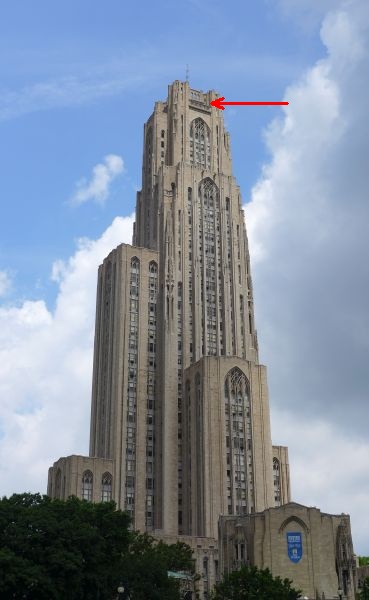
Question: Where should I look to see the peregrines at the University of Pittsburgh?
Answer: You cannot see the nest from inside the building nor can you see it from the street. However, you can see the peregrines themselves if you …
Look high up on the Cathedral of Learning.
If you see a bird perched on the antenna, it’s a peregrine. If you see a bird at or near the top, it’s a peregrine. No other birds dare fly up there because the peregrines will attack or eat them. This applies at all times of year.
During the nesting season, late March to early June, the peregrines will be on the Forbes Avenue side so the following instructions apply:
The best place to stand when looking for them is at Schenley Plaza, the park between Hillman and Carnegie Libraries and across the street from the Cathedral of Learning. It helps to be closer to the tent than to Forbes Ave.
Don’t attempt to see the peregrines from inside the building. You can’t see the nest from any window and it’s illegal to disturb the birds. And you can’t run from floor to floor as fast as a peregrine can fly so you’ll miss them. Truly, the best way to see the peregrines is from the ground.
In the last week before the nestlings fly — in early June — they walk the edges of the building and flap their wings. To see them from Schenley Plaza, use binoculars and…
- Look at the antenna (actually a lightning rod) on top of the building. If there’s a lump on one of its perches that’s a peregrine, so look closely.
- Follow the antenna down until you see 3 windows with the sky showing through them. Those windows have golden lights at their base.
- Look below the windows and you’ll see a roof.
- Look below the roof and you’ll see a wall with 5 architectural cutout designs. This area is where they’re likely to be.
- The top of the wall is called the “nest rail.” This is where the parents perch to look down on the nest and where the youngsters practice flapping their wings and making small test flights before they fledge.
- The architectural cutouts are called the “keyholes.” Look in the far right keyhole. There is sometimes a peregrine perched inside it.
Note! During the nesting season, it is very important to watch from the ground, not from inside a window. A nestling that’s frightened by seeing a human may leap off the building before it can fly and fall to its death.
(photo by Kate St. John)
Thanks for the visual, Kate. It really helps. I didn’t realize the peregrines were at the tippy top!